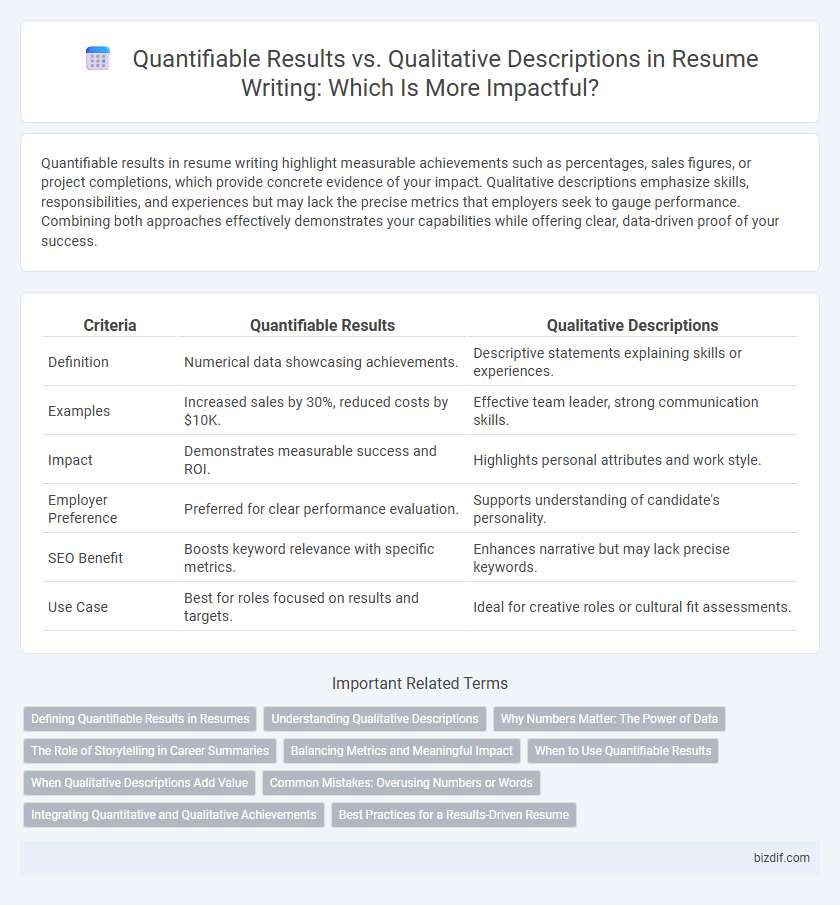Quantifiable results in resume writing highlight measurable achievements such as percentages, sales figures, or project completions, which provide concrete evidence of your impact. Qualitative descriptions emphasize skills, responsibilities, and experiences but may lack the precise metrics that employers seek to gauge performance. Combining both approaches effectively demonstrates your capabilities while offering clear, data-driven proof of your success.
Table of Comparison
| Criteria | Quantifiable Results | Qualitative Descriptions |
|---|---|---|
| Definition | Numerical data showcasing achievements. | Descriptive statements explaining skills or experiences. |
| Examples | Increased sales by 30%, reduced costs by $10K. | Effective team leader, strong communication skills. |
| Impact | Demonstrates measurable success and ROI. | Highlights personal attributes and work style. |
| Employer Preference | Preferred for clear performance evaluation. | Supports understanding of candidate's personality. |
| SEO Benefit | Boosts keyword relevance with specific metrics. | Enhances narrative but may lack precise keywords. |
| Use Case | Best for roles focused on results and targets. | Ideal for creative roles or cultural fit assessments. |
Defining Quantifiable Results in Resumes
Quantifiable results in resumes refer to specific, measurable achievements that demonstrate the impact of your work, such as increasing sales by 30% or reducing processing time by 15 hours per week. These metrics provide concrete evidence of effectiveness, making your accomplishments more compelling to employers. Highlighting quantifiable results distinguishes your resume by showcasing tangible contributions rather than vague or subjective descriptions.
Understanding Qualitative Descriptions
Qualitative descriptions in resume writing emphasize soft skills, leadership qualities, and personal attributes that demonstrate your work ethic and cultural fit. They provide context to your achievements by illustrating problem-solving abilities, teamwork, and communication skills, which cannot always be measured numerically. Hiring managers value these descriptions as they reveal how you approach challenges and contribute to the organizational environment beyond just numbers.
Why Numbers Matter: The Power of Data
Quantifiable results in resumes demonstrate concrete achievements, showcasing measurable impacts such as a 30% increase in sales or a 15% reduction in project completion time. Numbers provide clear evidence of skills and effectiveness, making candidates stand out to employers and applicant tracking systems. Data-driven achievements increase credibility and help hiring managers quickly assess the value a candidate can bring to their organization.
The Role of Storytelling in Career Summaries
In resume writing, quantifiable results such as "increased sales by 30%" provide clear evidence of achievements, while qualitative descriptions enrich storytelling by showcasing problem-solving abilities and leadership skills. Effective career summaries blend both elements, using data-driven accomplishments to anchor narrative examples that highlight professional growth and impact. Storytelling creates a compelling context around measurable outcomes, making resumes more memorable and persuasive to recruiters.
Balancing Metrics and Meaningful Impact
In resume writing, balancing quantifiable results with qualitative descriptions enhances the impact by showcasing both measurable achievements and meaningful contributions. Incorporating specific metrics such as percentage increases, revenue growth, or project completion times alongside narrative elements of teamwork, leadership, and problem-solving provides a comprehensive view of candidate capabilities. This approach ensures hiring managers see not only what was accomplished but also how those achievements align with organizational goals and values.
When to Use Quantifiable Results
Using quantifiable results in a resume is essential when highlighting achievements that can be measured with numbers, such as sales increases, project completion rates, or customer satisfaction scores. Numeric data provides concrete evidence of impact, making it easier for employers to assess performance and value. Focus on quantifiable results when specific metrics demonstrate success, efficiency improvements, or goal attainment.
When Qualitative Descriptions Add Value
Qualitative descriptions add value in resume writing by highlighting soft skills such as leadership, creativity, and adaptability that are not easily measured by numbers. They provide context for quantifiable results, offering deeper insight into problem-solving approaches and team dynamics. Including specific examples of qualitative achievements creates a more well-rounded and compelling candidate profile.
Common Mistakes: Overusing Numbers or Words
Overusing numbers in resumes can overwhelm recruiters and dilute the impact of key achievements, while relying too heavily on qualitative descriptions may lack measurable proof of success. Balancing quantifiable results, such as "increased sales by 30%," with concise qualitative insights, like "enhanced team collaboration," creates a compelling narrative. Avoid cluttering resumes with excessive metrics or vague adjectives to maintain clarity and effectiveness.
Integrating Quantitative and Qualitative Achievements
Integrating quantitative achievements with qualitative descriptions enhances resume impact by showcasing measurable results alongside contextual skills. Highlighting specific metrics such as sales growth, project completion rates, or customer satisfaction scores provides concrete evidence of success. Combining these with qualitative details like leadership qualities and problem-solving abilities offers a comprehensive view of professional accomplishments.
Best Practices for a Results-Driven Resume
Highlight quantifiable results in your resume by including specific metrics such as percentage increases in sales, number of projects completed, or revenue growth, which demonstrate tangible achievements. Complement these with qualitative descriptions that emphasize skills and leadership qualities to provide context and showcase your value beyond numbers. Emphasize action verbs paired with data to create a compelling narrative that attracts recruiters and optimizes your resume for applicant tracking systems.
Quantifiable results vs Qualitative descriptions Infographic

 bizdif.com
bizdif.com